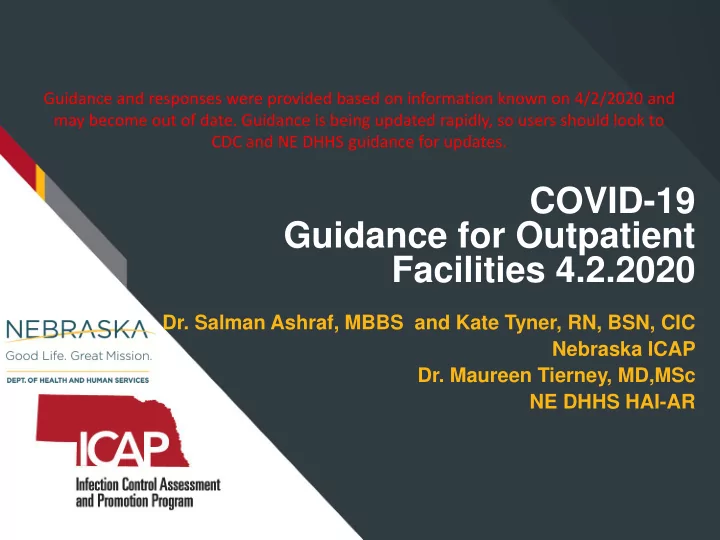

Guidance and responses were provided based on information known on 4/2/2020 and may become out of date. Guidance is being updated rapidly, so users should look to CDC and NE DHHS guidance for updates. COVID-19 Guidance for Outpatient Facilities 4.2.2020 Dr. Salman Ashraf, MBBS and Kate Tyner, RN, BSN, CIC Nebraska ICAP Dr. Maureen Tierney, MD,MSc NE DHHS HAI-AR
Prioritize Urgent and Emergency Visits https://www.cdc.gov/coronavirus/2019-ncov/healthcare- facilities/index.html
Use strategies to separate the well from the sick • Scheduling well visits in the morning and sick visits in the afternoon • Separating patients spatially, such as by placing patients with sick visits in different areas of the clinic or another location from patients with well visits. • Collaborating with providers in the community to identify separate locations for holding well visits for children. https://www.cdc.gov/coronavirus/2019-ncov/healthcare- facilities/index.html
American Academy of Pediatrics • If a practice can provide only limited well child visits, healthcare providers are encouraged to prioritize newborn care and vaccination of infants and young children (through 24 months of age) when possible. • Dedicate specific rooms for sick visits and well visits; or for those with multiple practice sites to consider using one office location to see all well visits • If available, utilize “drive through” dedicated COVID -19 testing sites https://services.aap.org/en/pages/covid-19-clinical- guidance-q-a/
Voluntary Universal Masking • Healthcare workers wear a mask during clinical care • Achieves source control and decreases risk of spreading infection: protects patients and other healthcare workers if the healthcare worker have pre-symptomatic or asymptomatic COVID-19 • Implemented by facilities on a voluntary basis when the jurisdiction is experiencing community spread • Requires very strict adherence to • Extended use/reuse • Meticulous hand hygiene • Proper use and hygiene of the mask https://www.nebraskamed.com/sites/default/files/documents/c ovid-19/surgical-mask-policy-and-faq-nebraska-med.pdf
https://med.emory.edu/departments/medicine/divisions/infectious-diseases/serious-communicable-diseases- program/covid-19-resources/conserving-ppe.html
Clean and Disinfect If surfaces are dirty, they should be cleaned using a detergent or soap and water prior to disinfection. For disinfection, most common EPA-registered household disinfectants should be effective. – A list of products that are EPA-approved for use against the virus that causes COVID-19 is available here. Follow manufacturer’s instructions for all cleaning and disinfection products for (concentration, application method and contact time, etc.). – Additionally, diluted household bleach solutions (at least 1000ppm sodium hypochlorite) can be used if appropriate for the surface. Follow manufacturer’s instructions for application, ensuring a contact time of at least 1 minute, and allowing proper ventilation during and after application. Check to ensure the product is not past its expiration date. Never mix household bleach with ammonia or any other cleanser. Unexpired household bleach will be effective against coronaviruses when properly diluted. Prepare a bleach solution by mixing: – 5 tablespoons (1/3 rd cup) bleach per gallon of water or – 4 teaspoons bleach per quart of water https://www.cdc.gov/coronavirus/2019- ncov/prepare/disinfecting-building-facility.html
Community Spread: After options to improve staffing have been exhausted In consultation with their occupational health program- Facilities could consider allowing asymptomatic HCP who have had an exposure to a COVID-19 patient to continue to work: • These HCP should still report temperature and absence of symptoms each day prior to starting work. • Facilities could have exposed HCP wear a facemask while at work for the 14 days after the exposure event if there is a sufficient supply of facemasks. • If HCP develop even mild symptoms consistent with COVID- 19, they must cease patient care activities, don a facemask (if not already wearing), and notify their supervisor or occupational health services prior to leaving work http://dhhs.ne.gov/han%20Documents/ADVISORY%2003232020.pdf
Discontinuation of Transmission-Based Precautions and Disposition of Patients with COVID-19 in Healthcare Settings (Interim Guidance) Guidance as of March 23, 2020 • Patients with COVID-19 can be discharged from a healthcare facility whenever clinically indicated. • Discontinuation of empiric transmission-based precautions for patients suspected of having COVID- 19. • When using a testing-based strategy for discontinuation of transmission-based precautions is preferred. https://www.cdc.gov/coronavirus/2019-ncov/hcp/disposition-hospitalized- patients.html
Discontinuation from self-isolation: CDC guidance states that an individual can stop self-isolation if: • It has been at least 7 days since symptoms first appeared AND • No fever for at least 72 hours (fever-free for 3 full days off fever-reducing medicine) AND • All other symptoms have improved (e.g., cough has improved) www.cdc.gov/coronavirus/2019-ncov/if-you-are-sick/steps-whensick.html And http://dhhs.ne.gov/han%20Documents/ADVISORY%2003232020.pdf
Discontinuation from self-monitoring and self- quarantine: Discontinuation from self-quarantine and self-monitoring may cease if after 14 days there has been NO development of respiratory illness symptoms. Symptoms may include: • Fever • Cough • shortness of breath • sore throat • runny nose. http://dhhs.ne.gov/han%20Documents/ADVISORY%2003232020.pdf
Infection Prevention and Control Office Hours Monday – Friday 7:30 AM – 9:30 AM Central Time 2:00 PM -4:00 PM Central Time Call 402-552-2881
Questions and Answer Session Use the QA box in the webinar platform to type a question. Questions will be read aloud by the moderator, in the order they are received A transcript of the discussion will be made available on the ICAP website Panelists today are: Dr. Salman Ashraf, MBBS Dr. Maureen Tierney, MD,MSc Kate Tyner, RN, BSN, CIC Margaret Drake, MT(ASCP),CIC Teri Fitzgerald RN, BSN, CIC https://icap.nebraskamed.com/resources /
Airborne Contaminant Removal CDC Environmental Infection Control in Healthcare Facilities (2003) Air Exchanges per hour Time (in minutes) required for Time (in minutes) required for removal 99% efficiency removal 99.9% efficiency 2 138 207 4 69 104 6 46 69 8 35 52 10 28 41 Values apply to an empty room with no aerosol-generating source. With a person present and generating aerosol, this table would not apply. Removal times will be longer in rooms or areas with imperfect mixing or air stagnation. Caution should be exercised in using this table in such situations. https://www.cdc.gov/infectioncontrol/guidelines/environmental/appendix/air.html#tableb1
http://dhhs.ne.gov/Documents/COVID- 19%20Screening%20and%20Testing%20Information.pdf
Nebraska Medicine N95 Decontamination Resources Extended Use and Reuse of PPE Guidance https://www.nebraskamed.com/sites/default/files/documents/covid- 19/COVID-Extended-Use-Reuse-of-PPE-and-N95.pdf?date03212020 N95 Filtering Facepiece Respirator Ultraviolet Germicidal Irradiation (UVGI) Process for Decontamination and Reuse (updated 3/26/2020) https://www.nebraskamed.com/sites/default/files/documents/covid-19/n- 95-decon-process.pdf?date=03262020 Site source: Nebraska Medicine COVID-19 Resources for Providers https://www.nebraskamed.com/for-providers/covid19
Recommend
More recommend